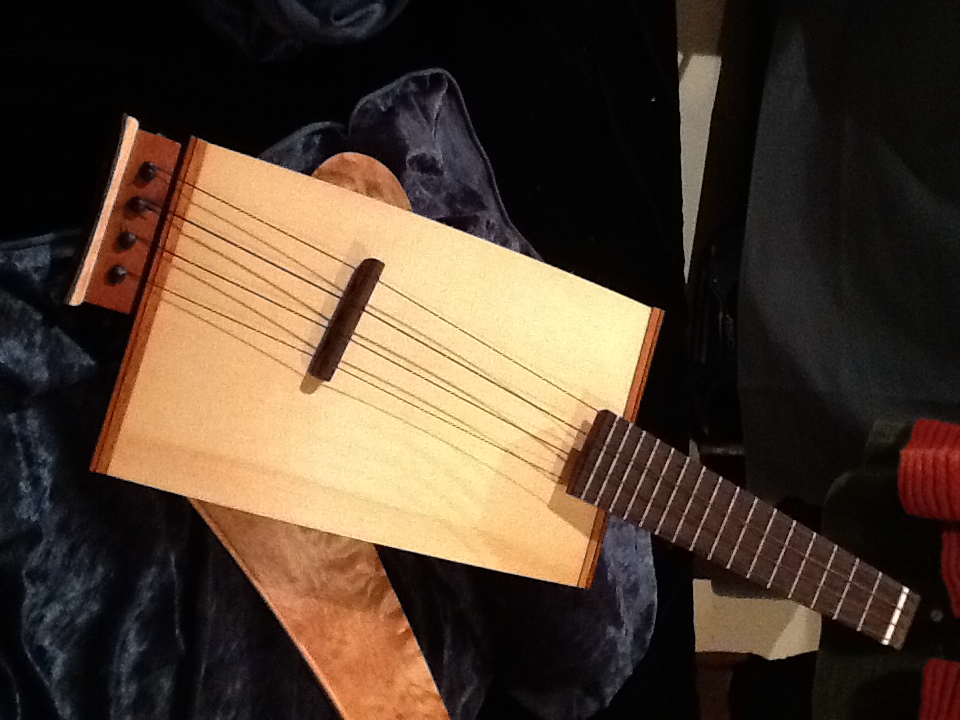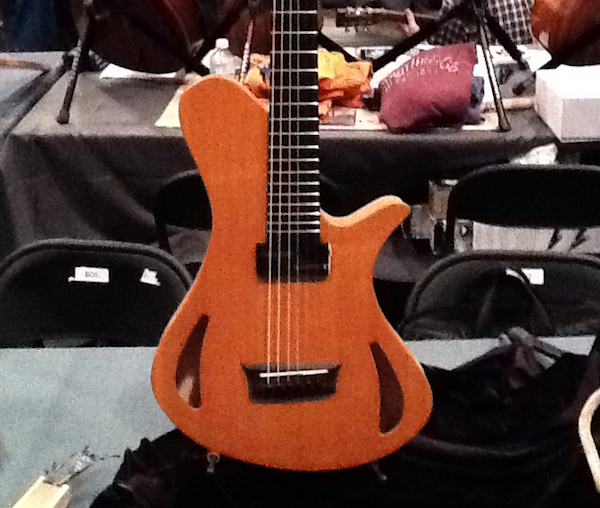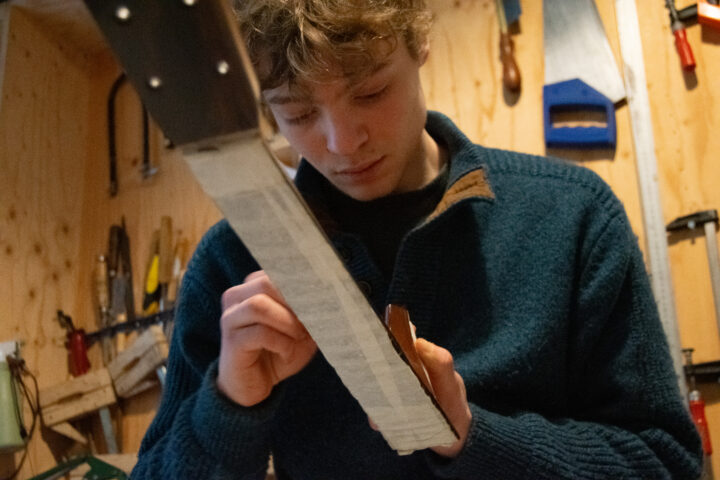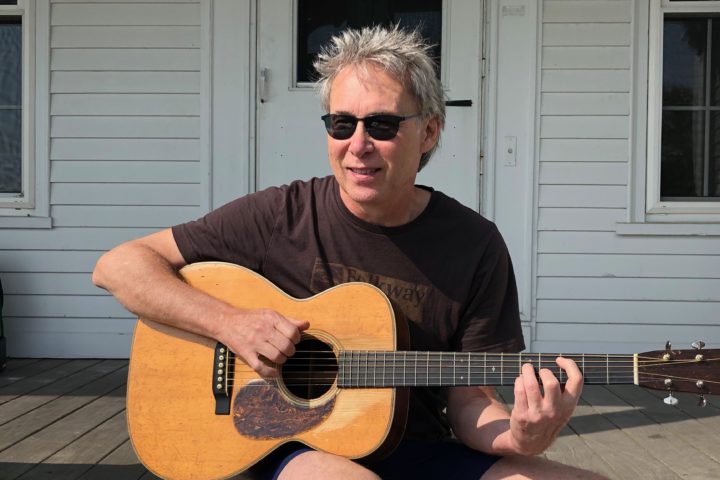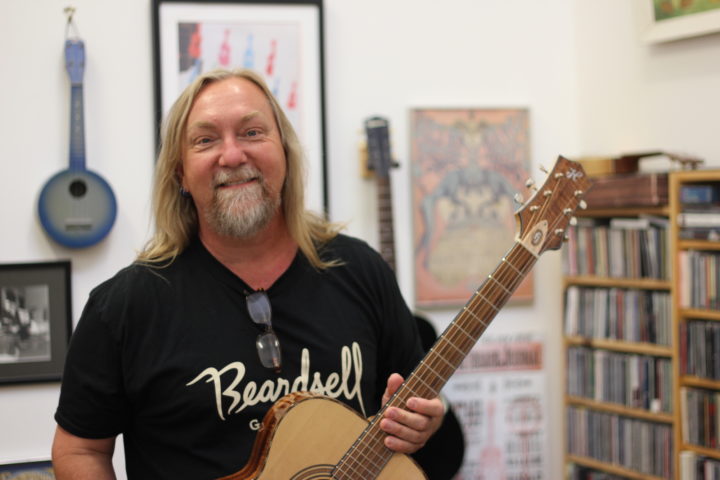Visiting the Woodstock Invitational Luthiers Showcase (held October 22 and 23, 2011) is like spending a weekend in a candy shop. Founder and producer Baker Rorick has presented the show publicly for three years (following an initial private gathering) at the Bearsville Theater on the west end of town. Each year the event has grown in stature, regularly attracting a number of heavy hitters including John Monteleone (who arrived late Saturday due to traffic), Linda Manzer, Cristian Mirabella and Ken Parker, whose inventive, impossibly light archtops continue to be a main attraction to pickers as well as an inspiration for builders.
Local makers with international reputations are also well-represented. This year, for example, Joe Veillette, who builds just down the street from the venue, showed off a doubleneck combining a six-string with his popular, high-tuned unison twelve-string Gryphon. Former Veillette partner Harvey Citron, another Woodstocker, displayed an ongoing series of acoustic/electrics featuring single-piece hollowbody construction and hand-wound pickups. And Selkirk New York’s David LaPlante brought along a few of his latest Spanish-style nylon string guitars.
Now that veteran showcase-goers have had a chance to become familiarized with some of the luthiers — hipping each other, say, to Bruce Sexauer’s wonderfully comfortable fan-fretted, mixed-scale small bodies — novelty and invention have a stronger sway. Oakland’s Michihiro Matsuda, for example, drew a steady stream of the curious to his corner table with a Picasso-esque “De-constructed Ukulele.”
One player commented that Matsuda’s uke was the spaceship logically meant to follow the classic 1927 Aero uke. It featured a rectangle of honeycomb laminated spruce held under tension like a bridge bed. The lack of a traditional soundbox was less shocking than the odd angles of Matsuda’s machine, which features a redwood and maple veneer “body piece” for player comfort. Matsuda says he employed the Golden Mean in developing the experimental ukulele, applying the concept practically as well as philosophically.
The uke, featuring a mahogany neck, was completed with wenge appointments and Pegheds geared-tuners at the foot, rather than the head, of the instrument.
Just as a Saturday afternoon is no place to check out an old Martin at a suburban Guitar Center, the WILS is not the best place to sonically scope out a new toy unless you find a private room. The sound of Matsuda’s uke was essentially swallowed in the hubbub, but it drew many comments nonetheless.
One aisle over, Woody Phifer, from nearby Phoenicia, had a table filled with distinctive, cat’s-eyed archtops. WILS is specifically an acoustic show, but Phifer’s creations — suggested as a point of interest by collector/player Jeff Doctorow — are meant to be plugged in. Phifer’s been at the craft for 40 years, including a stint running the repair shop at Mandolin Brothers, but these axes represent the last decade of his innovation. Like Citron, Phifer is carving his backs and sides out of a single piece of wood, predominantly maple in Phifer’s case.
“I’m chasing the idea behind the djembe,” he said, “using one tree for one instrument.” Phifer even carves the back braces from the single piece, and he feels the uniformity of the wood results in a faster tonal response, forcing the top to work harder. He specifically builds towards a leaner bass response, noting that as a repairman he has seen too many fine guitars stuffed with foam or with f-holes taped over to fight feedback. The offset bodies are also an attempt to reduce reflective surfaces that create standing waves.
Martin Keith, a Woodstock native profiled in issue 20 of the magazine, is also trying to use natural acoustic properties to create better sounding electrics. Keith had one of his fine solidbody basses at his table, but was focusing on two experimental six-string guitars. One split the difference visually between Matsuda’s uke and a standard acoustic, with spruce wings representing a top, but with little more than air where sides might be.
The goal, Keith says, is to allow the box to lose acoustic energy in a similar way to a standard acoustic guitar. The result, he hopes, will eventually be an amplified guitar that achieves a more satisfactory acoustic sound than a standard piezo set-up.
Even more interesting was a purely experimental acoustic that Keith said amounts to “thinking out loud.”
Keith has long worked with Veillette, doing set-ups and electronics. More recently he has also been a presence in Parker’s shop, and it’s clear that his associations with both men have influenced his own work.
“The neck conversation” with Parker, for example, has led to Keith using a similar post attachment as well a user-adjustable action and neck angle. Other instruments employ Veillette’s single bolt t-nut attachment. The necks themselves feature a sandwiched construction with an outer shell of hardwood (maple) surrounding a c-shaped lightweight carbon fiber layer and an inner core of softwood (redwood). Keith is obsessed with instrument ergonomics and his basses have pioneered ways to lose weight without losing tone.
These new instruments — while admittedly experimental in nature — are an effort to further explore those concepts. –Michael Eck
